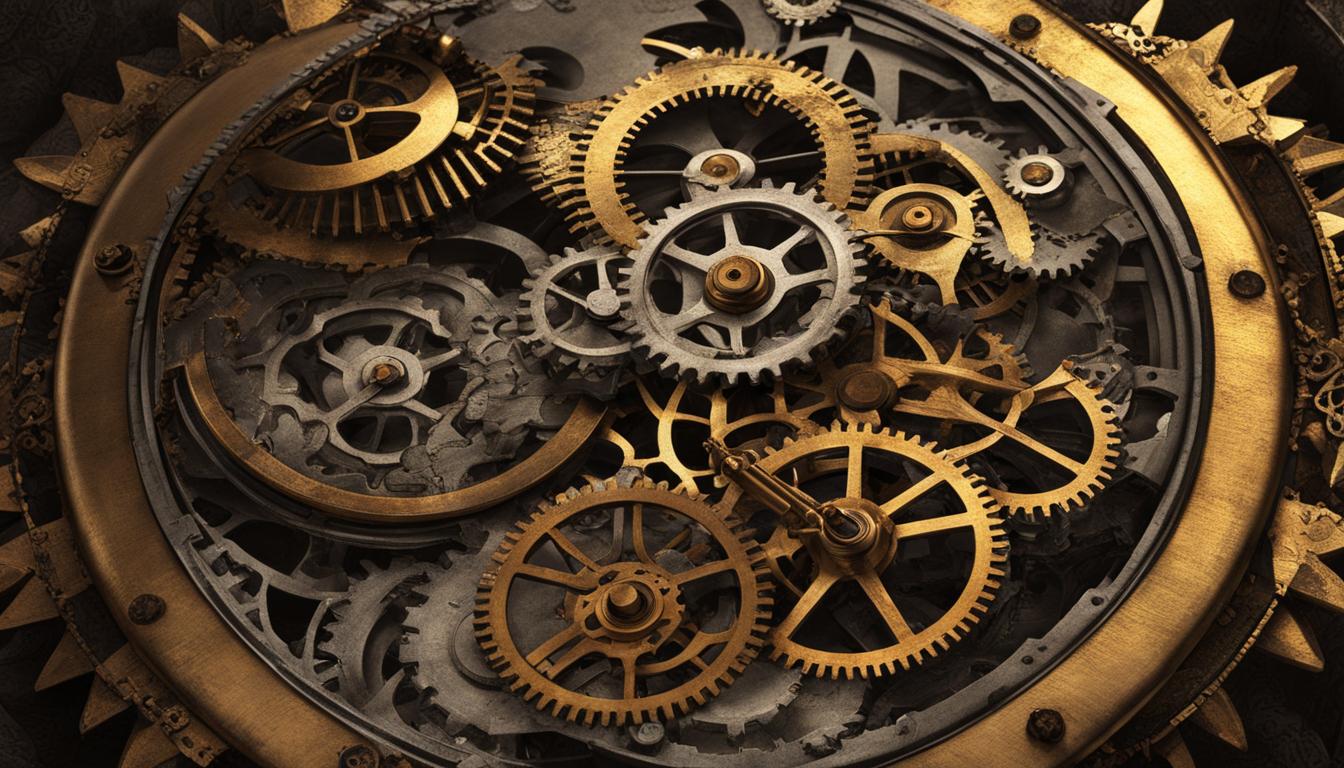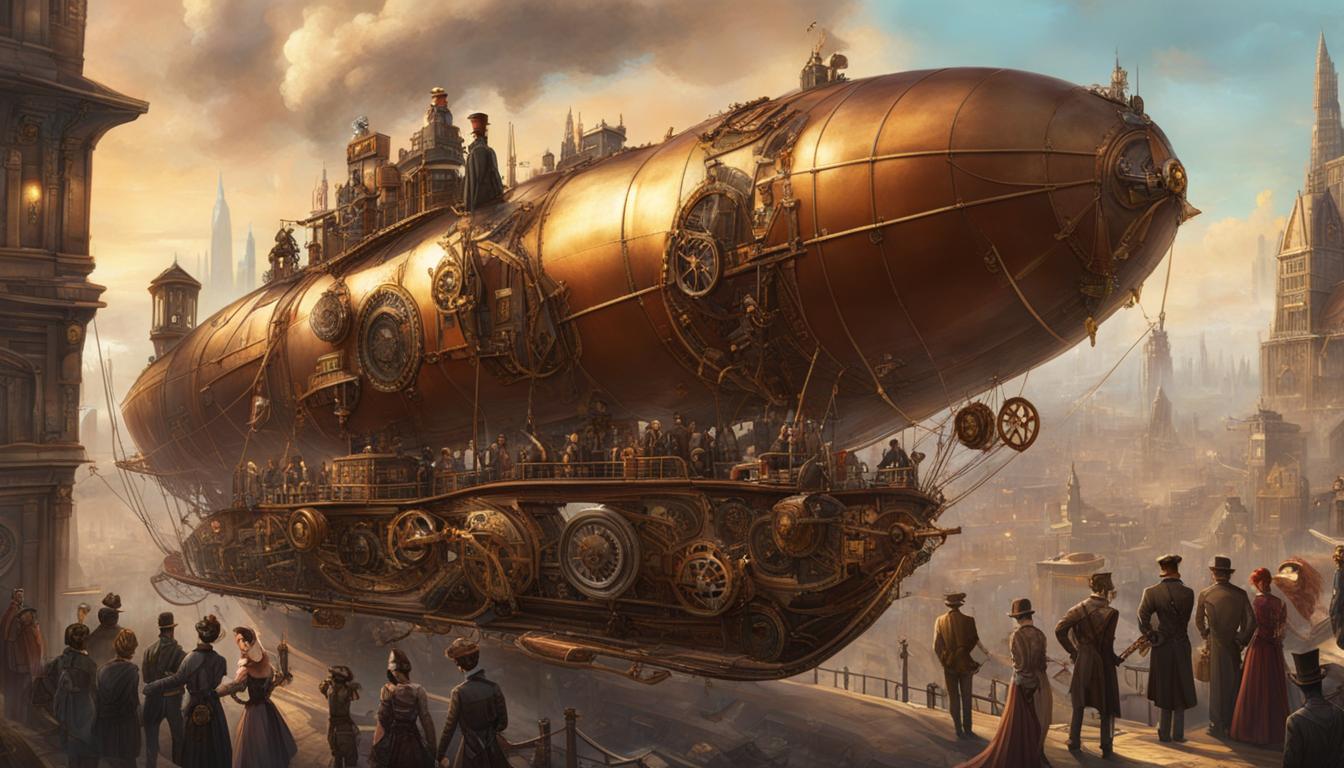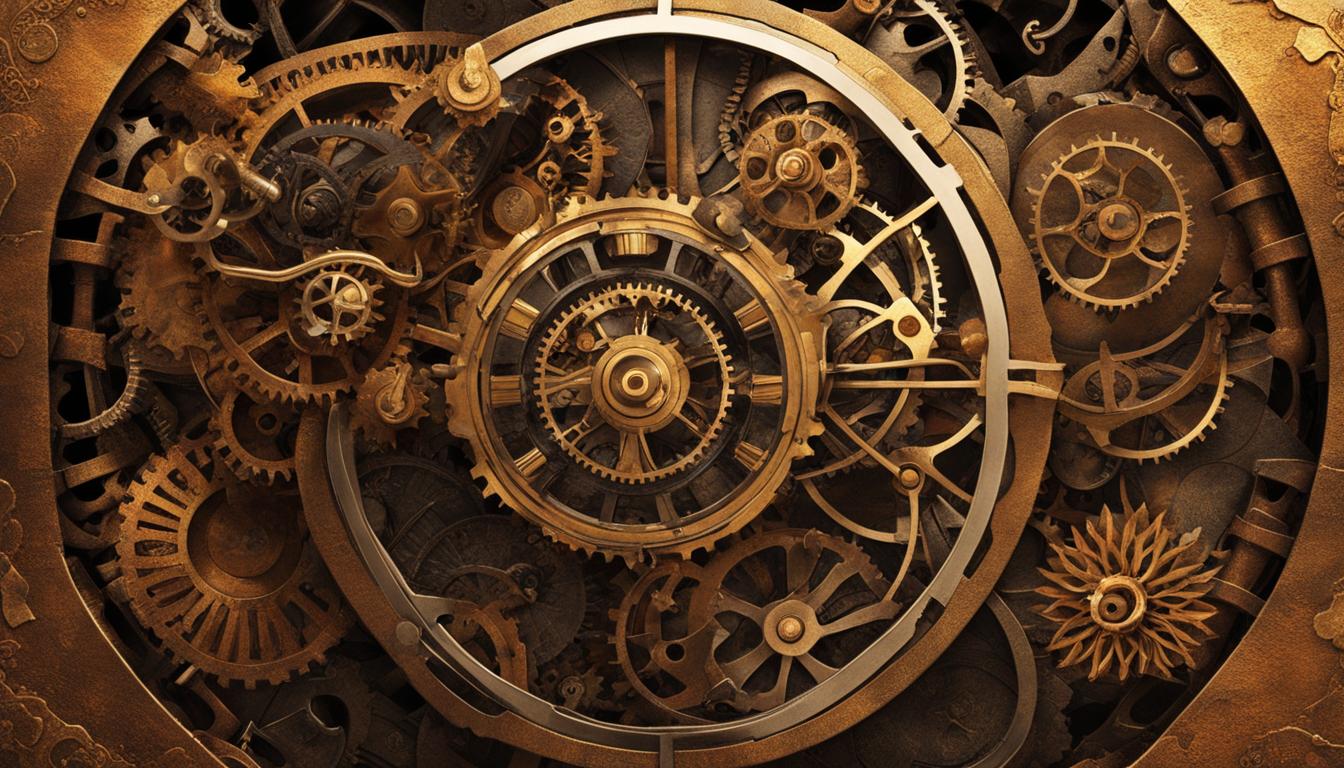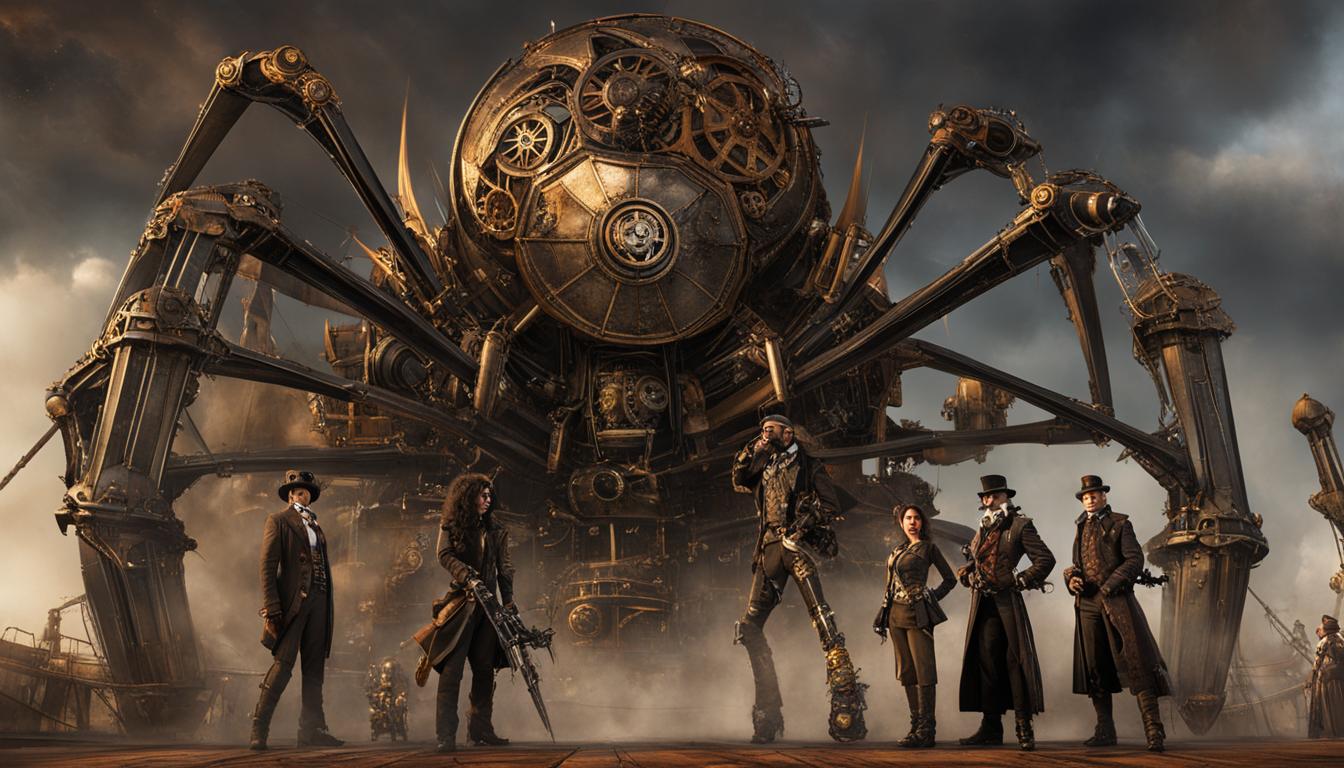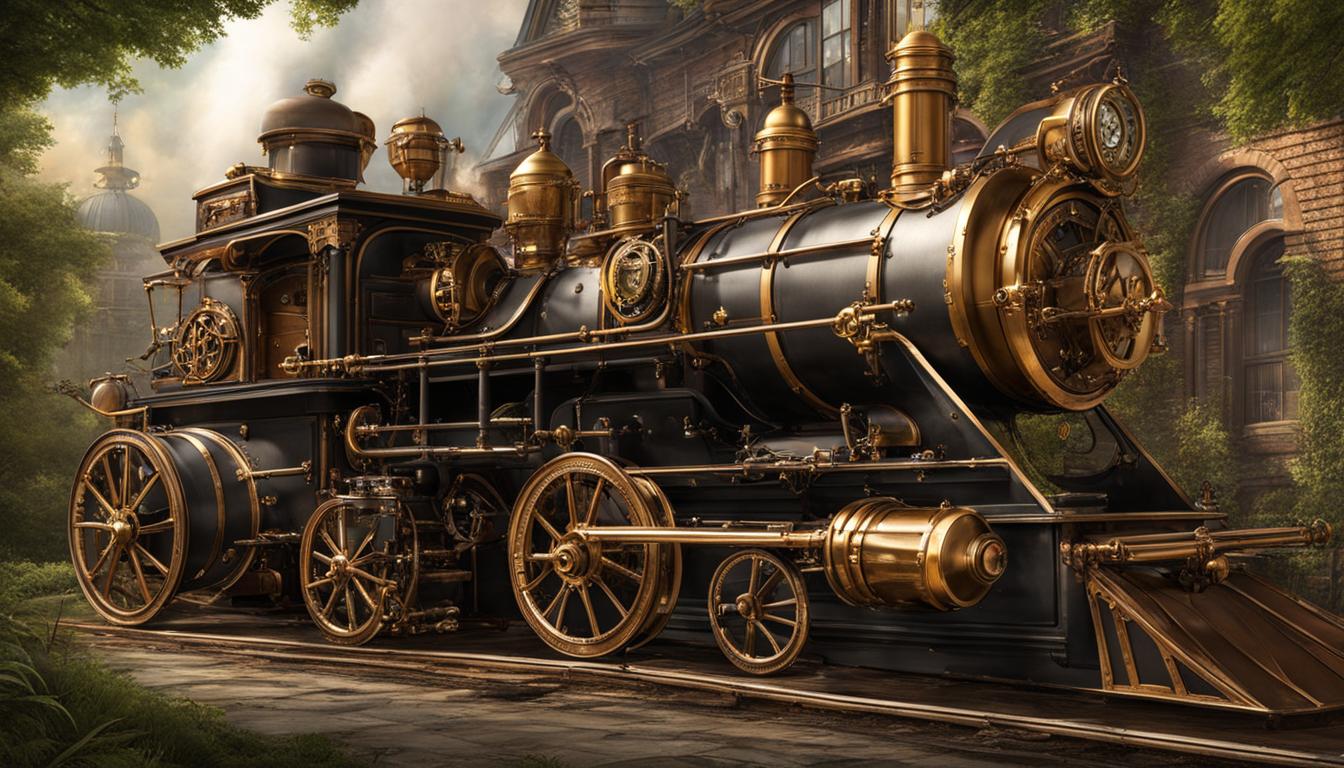Steampunk, the captivating subgenre of science fiction, has taken the world by storm in recent years, influencing art, fashion, and even film. But what lies beneath its mesmerizing aesthetic? Beyond the stunning visuals and fantastical inventions, steampunk carries profound philosophical messages that encourage readers to delve deeper into its narrative depths.
Steampunk is not just about corsets, clockwork, and top hats; it weaves together the past and the future, exploring themes that challenge conventional norms and spark innovation. This article will take you on a journey through the core themes of rebellion, innovation, and social reform present in steampunk literature, unraveling the layers of its philosophical commentary.
Key Takeaways:
- Steampunk combines the aesthetics of the Victorian era with futuristic elements.
- Core themes in steampunk include rebellion, innovation, and social reform.
- Steampunk offers a unique philosophical commentary on societal norms and human values.
- Research is essential to create an authentic steampunk story.
- Worldbuilding is crucial in crafting believable steampunk narratives.
Understanding the Steampunk Subgenre
The Steampunk subgenre immerses readers in a world that combines the charm of the Victorian era with the imaginative wonders of steam-powered technology. Rooted in the historical context of the Victorian era and the Industrial Revolution, Steampunk authors use these elements to create alternative histories where steam-powered inventions shape society.
Visually, Steampunk often features intricate details, ornate fashion, and fantastical contraptions. However, the subgenre goes beyond aesthetics to explore complex themes and ideas. By blending historical elements with futuristic concepts, Steampunk invites readers to envision a world where steam-powered technology drives innovation and shapes social structures.
In the Steampunk subgenre, steam-powered technology is the driving force behind the advancements that shape the world. From airships to automatons, these inventions add an element of wonder and fascination to the narrative. By intertwining technology with elements of the Victorian era, Steampunk offers a unique perspective on what could have been in a world where steam reigns supreme.
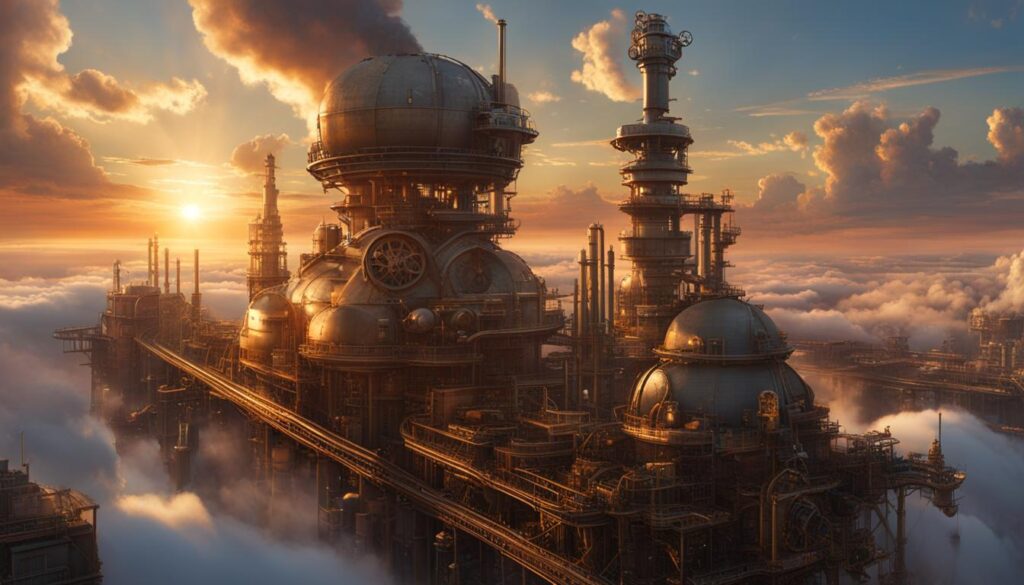
Table: Comparison of Common Themes in Steampunk
| Rebellion | Innovation | Social Reform | |
|---|---|---|---|
| Definition | Challenging norms and oppressive regimes | Fascination with invention and technological advancement | Addressing issues of inequality, justice, and workers’ rights |
| Key Elements | Individual agency, transformative actions | Steam-powered technology, alternate history | Examination of societal structures and norms |
| Impact | Inspiring change, questioning authority | Exploring ethical implications, consequences of progress | Raising awareness, promoting social justice |
Through these common themes, steampunk invites readers to imagine alternative worlds and examine the choices and actions that shape society. By provoking thought and challenging existing paradigms, steampunk literature provides a rich source of philosophical exploration that goes beyond mere entertainment.
Popular Steampunk Works
Steampunk has captivated readers with its imaginative worlds and compelling narratives. From alternate histories to post-apocalyptic landscapes, there is a plethora of popular steampunk works that have left a lasting impact on the genre. These influential steampunk novels showcase the creativity and depth of storytelling that has made steampunk a beloved subgenre of science fiction. Here are some noteworthy examples:
| Novel | Author | Description |
|---|---|---|
| The Difference Engine | William Gibson and Bruce Sterling | An alternate history where steam-powered computers revolutionize the Victorian era, exploring the consequences of advanced technology on society. |
| Mortal Engines | Philip Reeve | A post-apocalyptic future where cities roam on wheels, powered by steam, and the struggle for survival unfolds in a world of dwindling resources. |
| Boneshaker | Cherie Priest | A thrilling blend of gold rush fever, a zombie apocalypse, and steampunk engineering set in an alternate history Seattle. |
| Perdido Street Station | China Miéville | An industrialized city filled with strange creatures, where magic and technology intertwine, exploring themes of corruption and social inequality. |
| Airborn | Kenneth Oppel | An adventurous tale of airships, discovery, and high-flying exploits, transporting readers to a world of skies filled with wonder. |
These popular steampunk works offer a variety of narratives within the genre, showcasing different aspects of steampunk’s unique blend of history, technology, and adventure. Each novel immerses readers in a world filled with steam-powered wonders, social commentary, and unforgettable characters.
Image source:
Importance of Research in Steampunk Writing
Research plays a crucial role in crafting a compelling and authentic steampunk story. To transport readers into a believable alternative history, writers must delve into the details of the Victorian era, the technology of the time, and the social context. Historical authenticity adds credibility to the narrative, creating a sense of immersion for readers.
Steampunk is characterized by its fascination with technological innovation, and research allows writers to draw inspiration from real advancements of the era. By understanding the scientific discoveries and inventions of the time, writers can create imaginative and plausible inventions for their steampunk worlds. This attention to detail not only enriches the story but also adds to the overall aesthetic appeal of the genre.
“Research is to see what everybody else has seen and to think what nobody else has thought.” – Albert Szent-Gyorgyi
Furthermore, research is essential for capturing the social context of the 19th century. By studying the societal norms, class divisions, and political climate of the Victorian era, writers can develop well-rounded characters and create plots that resonate with readers. This understanding of the social landscape provides the foundation for exploring themes of rebellion, social reform, and the impact of technology on society.
The Significance of Historical Accuracy
While steampunk may take liberties with history, maintaining a sense of historical accuracy is important for grounding the narrative. By blending real historical events and figures with fictional elements, writers can create an immersive experience that feels both familiar and fantastical. Immersing readers in an authentic steampunk world requires a deep understanding of the past.
In conclusion, research is the backbone of successful steampunk writing. It allows writers to construct believable alternative histories, draw inspiration from technological advancements, and capture the social context of the Victorian era. By immersing themselves in the knowledge of the past, writers can transport readers to captivating steampunk worlds filled with adventure, innovation, and thought-provoking themes.
Creating the Steampunk World
Worldbuilding is an essential aspect of steampunk storytelling, as it lays the foundation for the narrative and brings the alternative history to life. Crafting a steampunk world requires attention to detail, creativity, and a deep understanding of the core elements that define the subgenre.
Steampunk worlds often blend elements of the Victorian era with imaginative inventions and technology. From the fashion and architecture to the social structures and technological innovations, every aspect of the world should adhere to the steampunk aesthetic. Attention to historical accuracy and logical thinking is crucial to creating a believable alternative history within the steampunk subgenre.
As a visual medium, steampunk often relies on vivid descriptions to transport readers into the world. The use of sensory details, such as the hiss of steam, the scent of oil, or the clanking of metal gears, helps immerse readers in the steampunk environment and enhances the overall reading experience. By engaging the reader’s senses, authors can create a more vivid and captivating world.
Worldbuilding Fundamentals
When building a steampunk world, several key elements should be considered:
- Technology: Steampunk is characterized by steam-powered technology and fantastical inventions. The technology should be integrated seamlessly into the world, providing practical uses and enhancing the overall aesthetic.
- Society: Social hierarchies, political structures, and cultural norms play a significant role in the steampunk world. Exploring the impact of technology and societal inequalities can add depth to the narrative.
- Environment: The setting of a steampunk world can range from bustling cities to remote, untamed landscapes. Capturing the essence of the environment through vivid descriptions helps create a rich and immersive reading experience.
- Conflict: Conflict is an essential component of any narrative. Whether it’s a rebellion against an oppressive regime or a clash of ideologies, the conflict in a steampunk world should reflect the core themes and provide a platform for exploring philosophical messages.
By carefully crafting a steampunk world, authors can transport readers to a captivating alternative history filled with adventure, intrigue, and philosophical exploration.
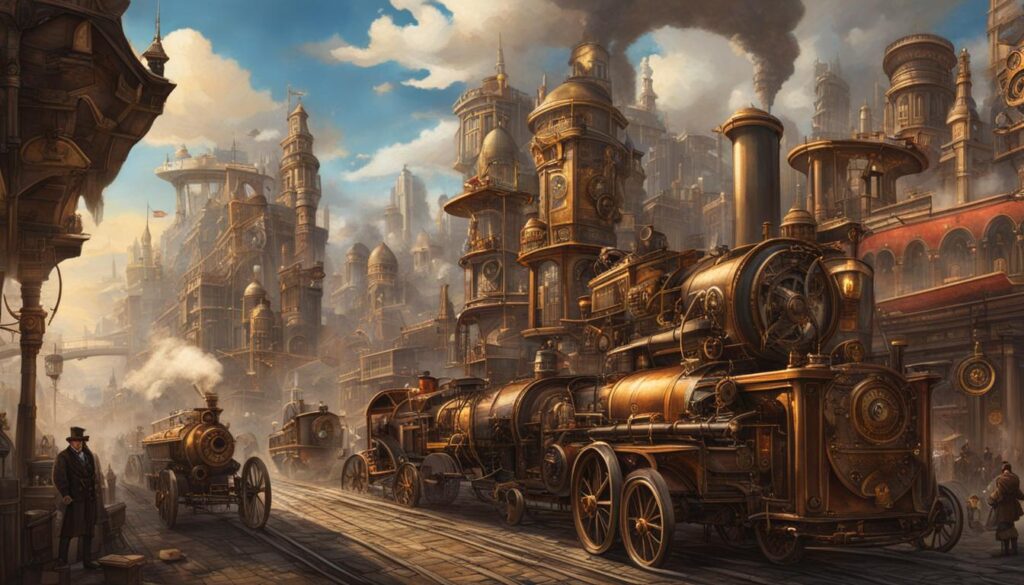
Steampunk and Retrofuturism
The relationship between steampunk and retrofuturism is a fascinating one, as both share similarities but also have distinct characteristics that set them apart. Steampunk, as we have explored, is deeply rooted in the Victorian era and revolves around steam-powered technology, while retrofuturism encompasses a broader range of time periods and technologies.
In steampunk, there is a strong emphasis on the aesthetics and innovations of the 19th century, with a fusion of past and future elements. This unique blend creates a nostalgic yet futuristic ambiance that defines the subgenre. Retrofuturism, on the other hand, adopts a more diverse approach by envisioning future technologies from the perspective of the past. It explores how earlier generations imagined and predicted advancements in science, technology, and society.
While both steampunk and retrofuturism delve into alternative histories and incorporate real-world social issues, steampunk’s focus on the Victorian era and its distinct visual style differentiate it from retrofuturism. Steampunk offers a more specific lens for examining the societal norms and values of the time, whereas retrofuturism allows for a broader exploration of various historical periods and the imaginative possibilities they hold.
Conclusion
As the steam-powered gears of the Victorian era merge with fantastical inventions, steampunk transcends its visual allure and delves into the depths of philosophy. Through rebellion, innovation, and social reform, steampunk conveys its profound messages on societal norms and the human condition.
Steampunk serves as a platform for exploring alternative histories and challenging the status quo. It encourages readers to question existing power structures and envision a world where change is possible. By examining the core themes of steampunk, we gain a deeper understanding of its underlying philosophical meaning.
Steampunk literature, art, and film take us on a journey through time, blending the past and the future in a unique fusion. As we immerse ourselves in this realm of extraordinary possibilities, we are urged to reflect on our own society and contemplate the potential for transformation.
So, the next time you don your goggles and corsets, remember that steampunk is more than just a style or an aesthetic choice. It is a profound exploration of rebellion, innovation, and social reform, offering us a glimpse into a world where the gears of change are in motion.
FAQ
What is steampunk?
Steampunk is a subgenre of science fiction that combines elements of the Victorian era with futuristic ideas, resulting in worlds filled with astonishing inventions and peculiar fashion.
What are the core themes in steampunk?
The core themes in steampunk include rebellion, innovation, and social reform. Steampunk explores these themes to provide a philosophical commentary on the human condition.
How does steampunk relate to the Victorian era?
Steampunk is firmly rooted in the historical context of the Victorian era. It reimagines the technological advancements and social inequalities of the time in a world where steam technology has led to advanced and fantastical inventions.
Can you give examples of popular steampunk works?
Notable examples of steampunk literature include “The Difference Engine” by William Gibson and Bruce Sterling, “Mortal Engines” by Philip Reeve, “Boneshaker” by Cherie Priest, “Perdido Street Station” by China Miéville, and “Airborn” by Kenneth Oppel.
Why is research important in steampunk writing?
Research is essential for crafting an authentic steampunk story. It helps create a believable alternative history, inspires fictional inventions, and adds depth to characters and plot.
What is worldbuilding in steampunk storytelling?
Worldbuilding is the process of creating the immersive backdrop and essence of a steampunk narrative. It involves blending elements of the Victorian era with imaginative inventions and technology to craft a believable alternative history.
How does steampunk differ from retrofuturism?
While both recall older eras and envision a better world through technological advancements, steampunk focuses specifically on the Victorian era and steam-powered technology. Retrofuturism encompasses a broader range of time periods and technologies.
What deeper philosophical messages does steampunk convey?
Steampunk carries philosophical messages through its exploration of rebellion, innovation, and social reform. It challenges societal norms, addresses real-world social issues, and inspires readers to reflect on the potential for change.

